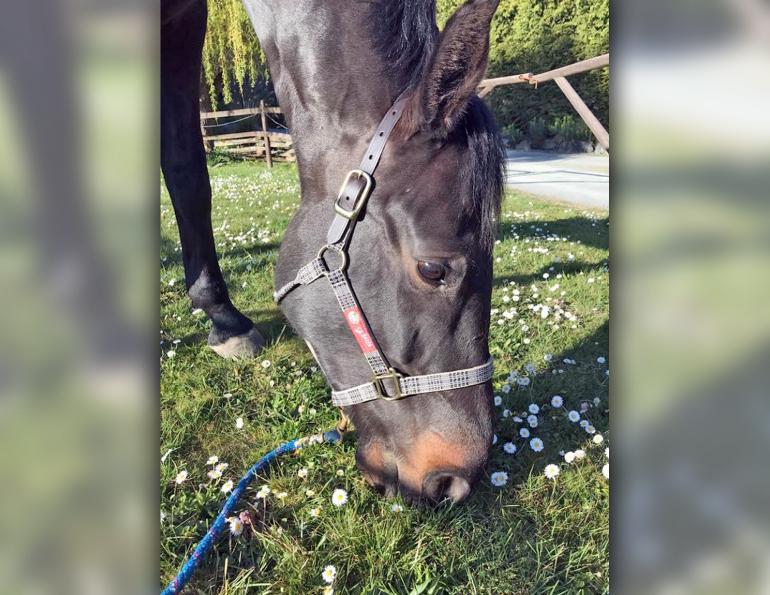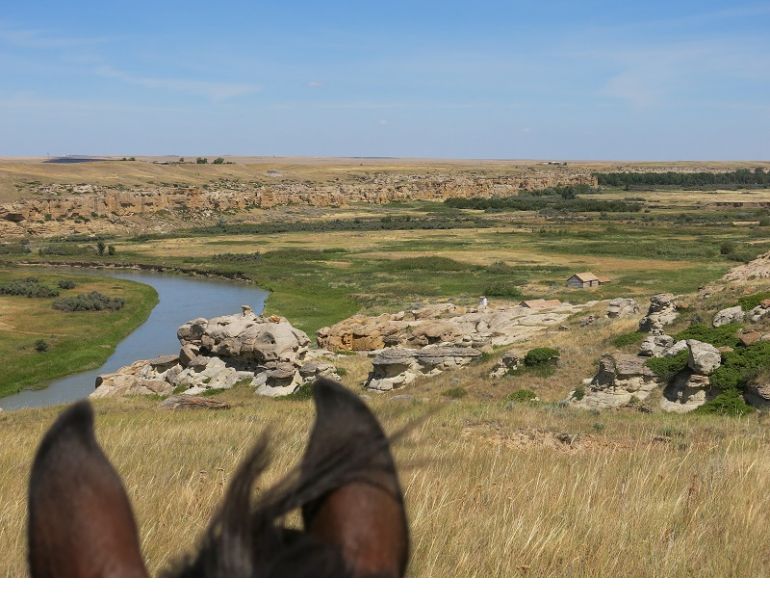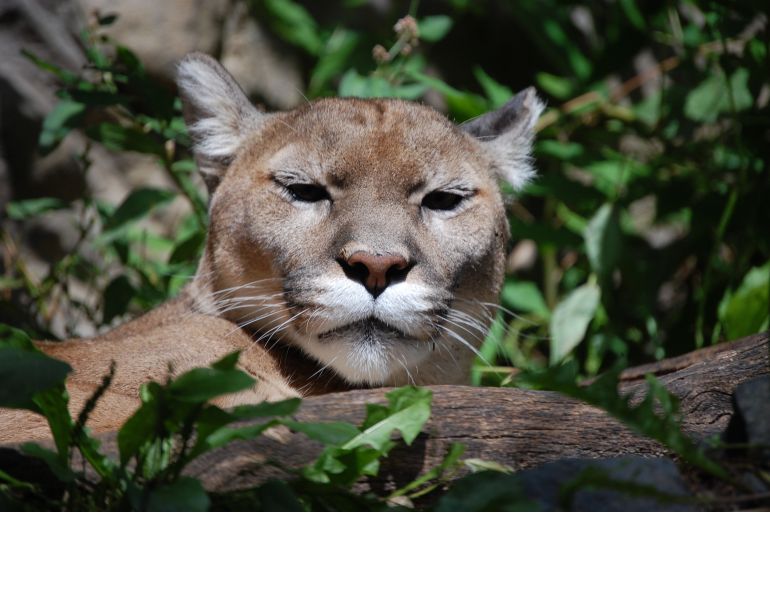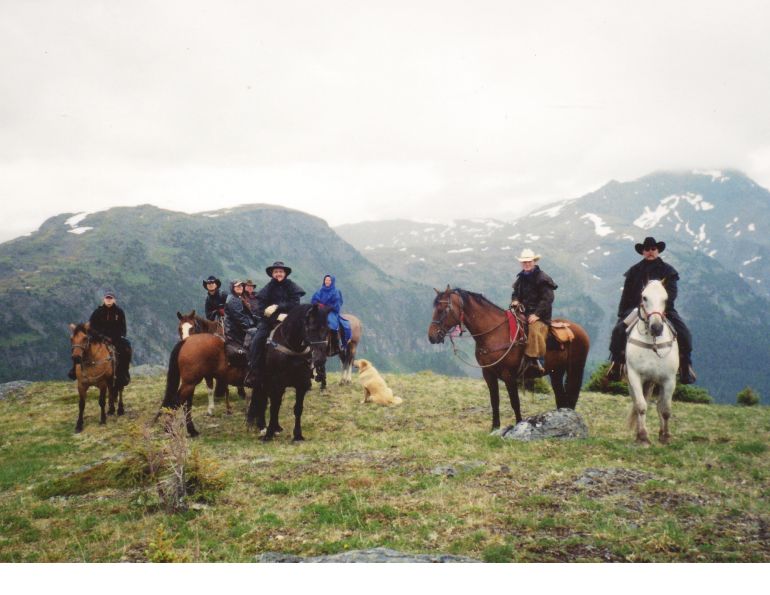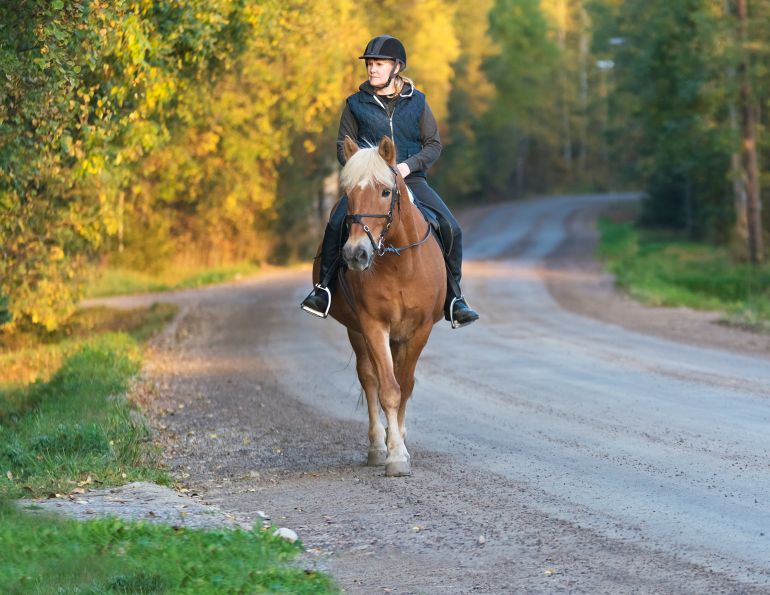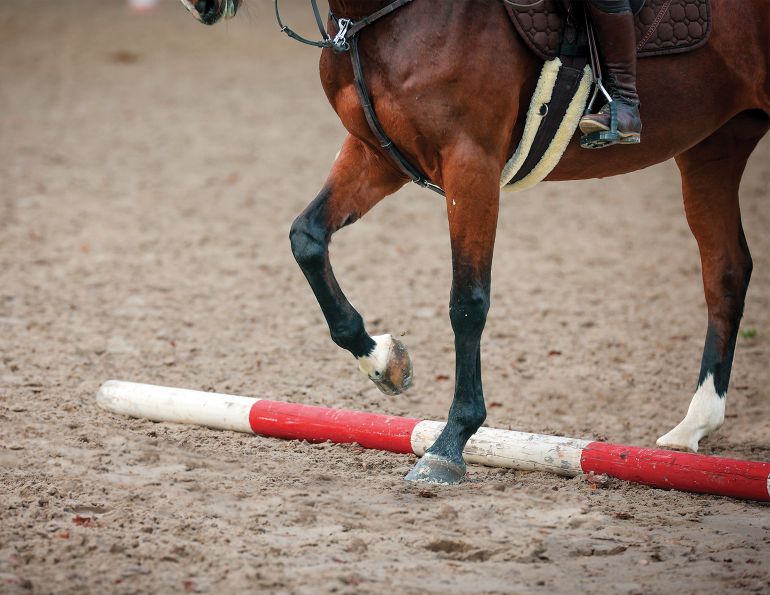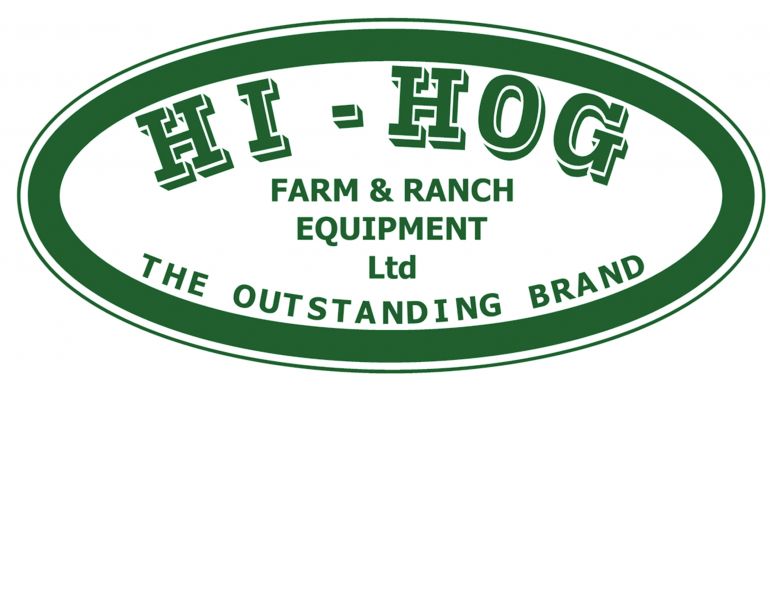By Stan Walchuk, Jr.
Several horses were haltered and tied up near the horse trailer. I went back out to the field, halter in hand, and walked up toward Honey, our bombproof old matriarch, then hesitated. She was noticeably wide through the gut. Good if we were expecting a foal, and bad because we needed to take her on the trail. How could this happen? She had never been pregnant in the several years that I had owned her. A few simple tests later and I remained uncertain, although she did look very proud of herself.
Erring on the side of caution, I replaced her with a three-year-old gelding with a good disposition but limited ground work, and decided to continue his training at the trailhead. After a long haul to the trailhead, several times around with the lunge line, some desensitizing, and an attempt with a saddle pad, he aggressively stepped in my direction. The pack saddle was received with even less enthusiasm: the youngster jumped forward, knocking me to the ground.
The truth is, in the name of haste, I had just broken almost every one of my own rules about proper ground work. I had cut corners in the past, generally smooth corners due to the calm, forgiving nature of the horses we breed, but now this gelding was throwing it all back in my face. And I deserved it. I had good reason to be concerned because the horse was heading out on a two week wilderness ride. A pushy horse that does not respect your space may be an inconvenience at home, but can be downright dangerous on the trail.
This was serious. We simply never allow a pushy horse on the trail. The problem is solved at home before we ever get to the trail; to do otherwise is not an option.
It is extremely important that your horse respects your space. Any number of situations could arise: the horse moves toward you and steps on your foot or clips your heel, or you go to halter or bridle him and he pulls his head away or pushes it toward you, causing you to lose your balance. You could get sandwiched between horses, or against a fence, building, trailer, vehicle, or worse. Horses that behave this way are lacking respect for your personal space.
Feeding a horse by hand encourages that horse to come into your space. Make sure that you have invited him to come to you and that you can send him away at any time. Photo: Courtesy of Stan Walchuk, Jr.
Working around multiple horses can be even more dangerous if they do not respect you. Double the number of disrespectful horses in close proximity to you, and you quadruple the potential problems. For example, you might go to feed horses and they charge into your space, shoving and kicking with anticipation, or you open a gate and they charge over you and knock you down.
We could all share a dozen stories about injuries from horses that find their roots in horses lacking respect for our space. We can talk all day about striving to be equal partners with the horse, and how to bond with and understand the horse, but at the end of the day that horse must not crowd your space or come into your space uninvited. Boundaries must be established.
Establishing these ground rules does not necessarily mean that you must be aggressive with your horse, but it does mean that you need to forget the idea that you are equal partners when it comes to physical space. To gain the respect needed to warrant that space you must be the dominant being in your partnership: the alpha horse.
We must strive to understand the way a horse thinks and its behaviour, and not expect that the horse should understand the way we think. Just watch herd dynamics and see how the horses’ movement, aggression, and body position marks their status, their right to push or move others, and their position in the herd hierarchy.
If a horse has been raised and trained to respect you and considers you dominant, there should never be a problem and no need for physical discipline or reprimand. If the horse lacks these boundaries there is a very real problem, and boundaries and dominance need to be established.
As trainer Marv Walker puts it, “I am totally against pre-emptive violence or physical retaliation, unless the horse uses it on me in a rebellious manner. I will return like for like. I do not initiate it, but I will try to return it in a manner that will match the herd boss’s response. I will treat him as a horse, not as a child, friend, what have you... by treating the horse as he expects to be [treated], and would be treated when left to its own devices in a herd, you operate in a manner the horse knows, understands, and accepts. When a horse knows, understands, and accepts something, it is comfortable and confident. At that point you have trust. It is when you drag the horse into human logic and reasoning that you have a problem.”
So how do you earn the freedom and space to move and use a horse safely, and what do you do when a horse habitually or aggressively intrudes into your space? There are two issues to consider: training to respect space, and dealing with problems as they arise.
First, understand that training a horse to respect your space does not mean that you are training a horse to avoid you, but rather training a horse to become comfortable in your presence and to enjoy coming into close contact with you when invited to do so.
Second, the horse must completely understand that you have the right to move him forward. When you have the right to move the horse then you have confirmed your position as the dominant horse. I have never seen a horse that moves freely upon request, and is willing to join up when asked, become pushy and disrespectful of the trainer’s or rider’s space. If this occurs, it is because the trainer removed the concepts of respect and boundaries, perhaps by allowing the horse to repeatedly move uninvited into close contact.
Does the above concept of forward movement and joining up sound familiar? Absolutely. It’s not rocket science, but simply early training with a lunge line and/or round pen.
Young horses and not-so-young horses when first exposed to the halter or a lariat may push or jump forward out of fear or desperation. These early stages of training need to be handled properly; if dealt with incorrectly you could end up with a pushy horse. If you react with fear and scramble to get out of the way, then the horse moving into your space will continue to do so, possibly aggressively, until the problem is remedied.
With young horses or horses with little or no handling, we always try to establish a relationship based on trust and comfort. We use treats freely before halter breaking to develop these things. At this time we also establish that we can come into the horse’s space as often as we wish, so that the horse completely accepts our presence and touch.
Once the horse understands this concept, it is not difficult to help him understand that although you are a friend and can enter his space, he cannot come freely into your space. Do this by introducing the horse to forward movement on the lunge line or in the round pen.
Once you achieve true join up, the horse’s mind is at its most willing, and you need to use this opportunity to establish movement in other directions. When you teach the horse ‘back,’ ‘over,’ and to drop its poll, you are not only establishing movements that you will constantly use on the trail, but are also demanding constant attention and respect from the horse because the horse’s mind is waiting for your cue before it gives the appropriate response. If the horse is looking to give you the requested response, especially when you ask him to move away from you, the chance that the horse will move into you in the future in close quarters is just about nil.
Possibly, repeated join up will create a mindset that anticipates join up to the point that the horse will no longer turn toward you only when asked, but also turn to you when it wants to. You need to immediately move these horses away and make sure they do not come into your space unless asked.
When our horses are comfortable with round pen work and know the routine, I change it by asking them to stay straight along the fence when I say ‘whoa.’ I do not have them come towards me as with early join up. This does two things: First, it is a precursor to the fact that soon you will be riding, and when you stop the horse under saddle you want the horse and his head stopping perfectly straight between the reins, and staying straight between the reins as you walk out. Second, it establishes that the horse is not to move toward you and teaches him to wait patiently for your next command. This means that nowhere in his thought process is the idea that he should move toward you or into your space; he is simply waiting and wondering what your next cue will be.
So what about the aggressive horse that charges toward you in the round pen? In these circumstances it is not uncommon for trainers to return aggression with like aggression. For example, if the horse charges the trainer in the round pen, the trainer, who should be aware and anticipating such a move, would use the whip aggressively to turn the horse from its path and keep it moving around the pen until respect is established. In this situation there is no need to whip the horse over the head as it charges toward you. Instead, anticipate the move, step to the side and out of the way, and aggressively, verbally, and with controlled contact in the flank or rear quarter, push the horse out of your space and forward. Soon the horse will learn that it avoids unpleasant confrontation by simply moving forward. Take a similar approach with a horse that kicks out its first time in the round pen. Always anticipate this possibility and allow yourself adequate space. Usually the horse that kicks out does so once or twice, then finds it less troublesome to simply move forward. Seriously aggressive horses should be handled by experienced trainers only.

Horses are large, powerful animals with hard hooves; humans are small and soft in comparison. Boundaries and respect are the keys to preventing injuries. Photo: Courtesy of Stan Walchuk, Jr.
Horses that step into you, shove into you, or jump toward you when being handled, like my young gelding, need to be immediately moved back out of your space. You can raise your hands and flag them aggressively and loudly command a backward motion, bumping back the halter rope (never the reins aggressively) if possible.
If the horse steps into you again, repeat the process. If it is a misdemeanor from a horse with no criminal record I simply bump the reins or bridle back and say ‘back,’ the horse moves back and is reminded about its place in life. At the other end of the spectrum, if the horse is a repeat offender, aggressive to the point of being dangerous, then I always go to the round pen or lunge line first. Once I establish the right to move the horse forward I continue to move him in other directions such as ‘back’ and ‘over.’ You can see good examples of this on www.Youtube.com under ‘horse respecting space.’
With young or untrained horses that move their faces into you, simply push the horse’s face out of your space with your hand, or aggressively rub the horse’s nose as you move it back. You should not have to slap or hit the horse to get the message across. I have also seen horse owners hold a hoof pick in their hand so that the sharp end protrudes a centimeter or so from between their index and middle fingers, and when the aggressive horse shoves its nose into the person, it bumps itself into the uncomfortable pick. This technique seems to have the desired effect but may be considered harsh by some.
Horses that push their faces into the rider or trainer often also pull their faces away during haltering, bridling, and deworming, etc. This may appear to be a separate issue from dealing with the pushy horse, but being pushy or aggressive is a state of mind that can manifest in many forms. If the horse is in control or dominant enough to push its face into you, it is also dominant enough to walk into your space, step on your foot, move a shoulder into you, or behave as it chooses.
Are there any situations where we let a horse come into our space without being asked? Yes, older horses and well trained horses that are sincere and honest, like old Honey (the kids’ bombproof companion who got left behind), and Donny (my Morgan gelding and friend for 16 years), know and respect the boundaries, and may come into my space for a rub or a scratch now and then. But don’t let it become a habit, especially one that you reward with rubs or treats. You can go into the horse’s space and give him a hug ten times a day, but letting him come into your space freely will erase your position as the dominant being even with friendly horses. Losing these boundaries means movement into your space and physical contact that you may not be able to control. Then it’s you versus 1100 pounds of equine force and hard hooves.
Remember, teach your horse to respect your space, and always be the alpha horse.
To read more by Stan Walchuk on this site, click here.
Main photo: Courtesy of Stan Walchuk, Jr. - A horse that moves into your space uninvited needs to immediately be directed away from you. Teach your horse to move forward, back, or to the side on command.





